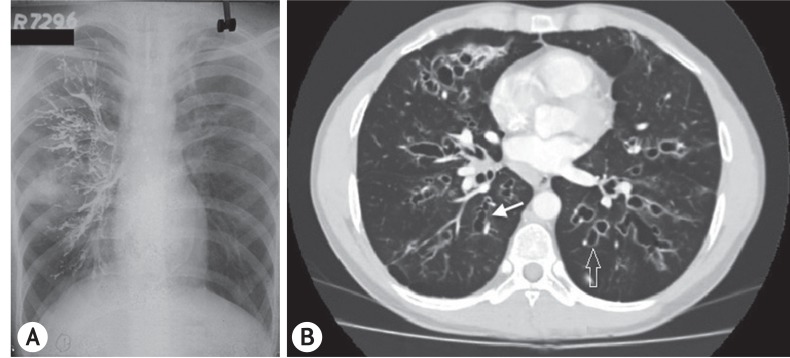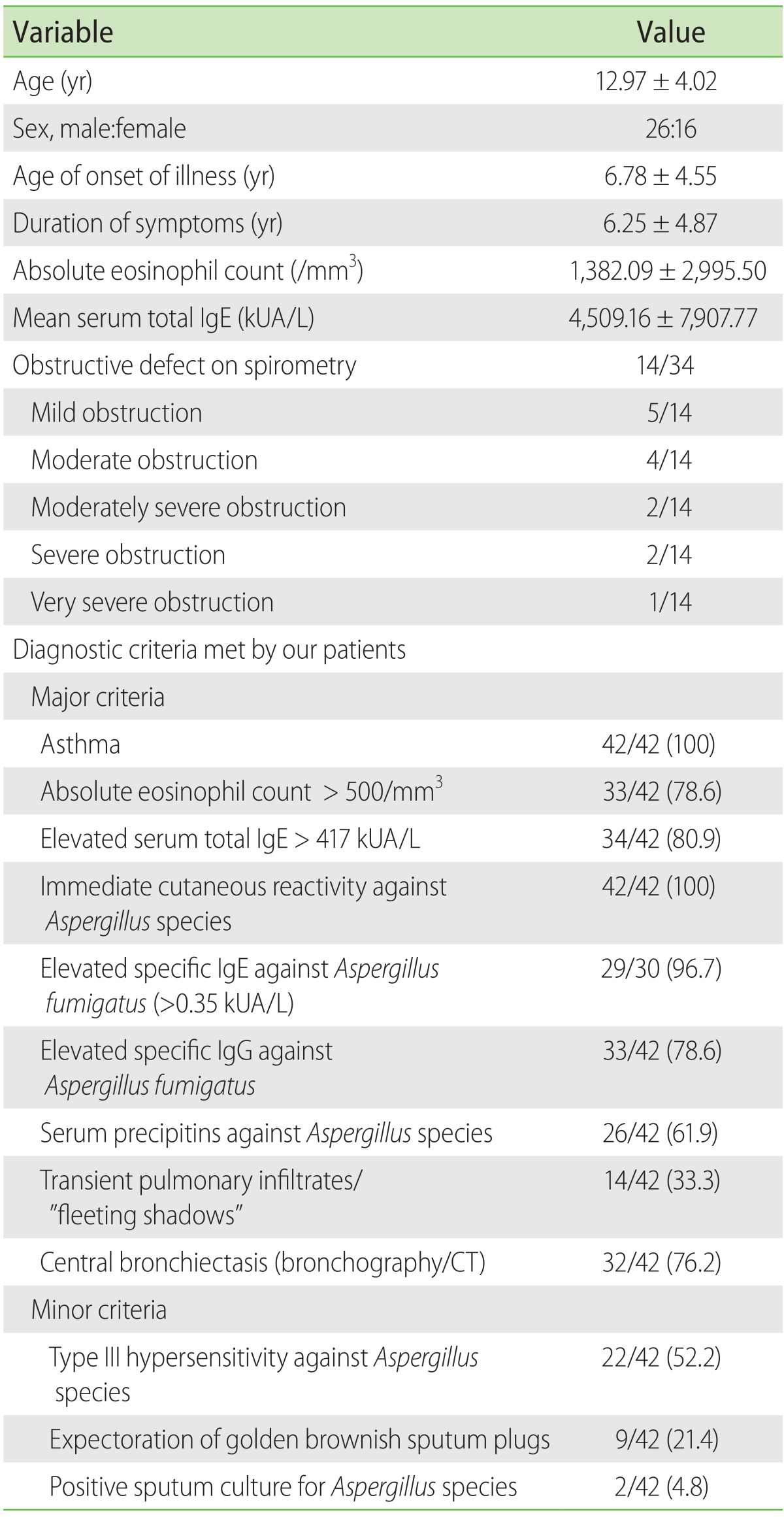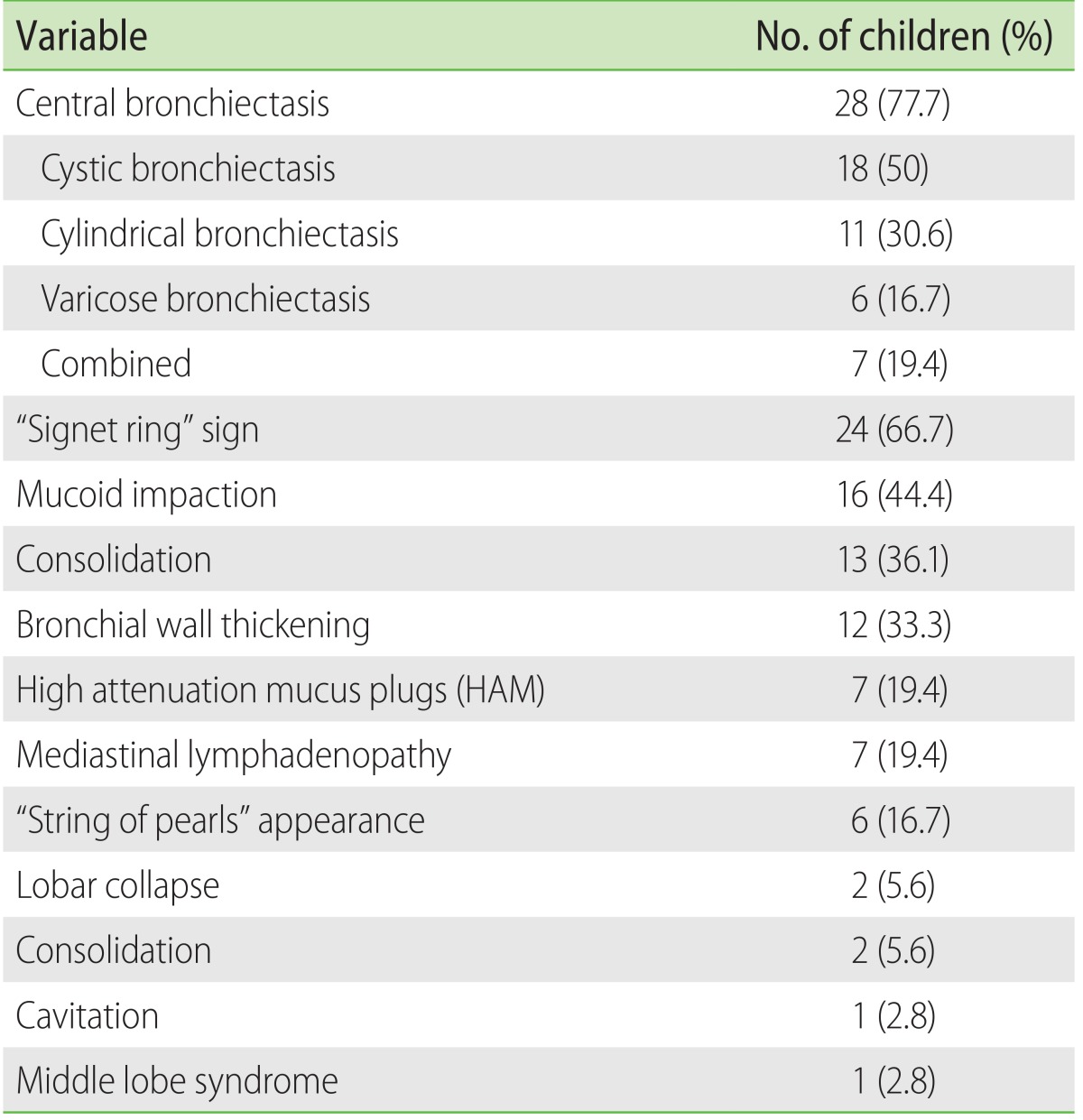1. Shah A, Panjabi C. Allergic bronchopulmonary aspergillosis: a perplexing clinical entity. Allergy Asthma Immunol Res. 2016; 8:282–297. PMID:
27126721.

2. Hinson KF, Moon AJ, Plummer NS. Broncho-pulmonary aspergillosis; a review and a report of eight new cases. Thorax. 1952; 7:317–333. PMID:
13015523.
3. Mann B, Pasha MA. Allergic primary pulmonary aspergillosis and Schonlein-Henoch purpura. Br Med J. 1959; 1:282–283. PMID:
13618621.

4. Geller DE, Kaplowitz H, Light MJ, Colin AA. Allergic bronchopulmonary aspergillosis in cystic fibrosis: reported prevalence, regional distribution, and patient characteristics. Scientific Advisory Group, Investigators, and Coordinators of the Epidemiologic Study of Cystic Fibrosis. Chest. 1999; 116:639–646. PMID:
10492265.
5. Sharma VK, Raj D, Xess I, Lodha R, Kabra SK. Prevalence and risk factors for allergic bronchopulmonary aspergillosis in Indian children with cystic fibrosis. Indian Pediatr. 2014; 51:295–297. PMID:
24825267.

6. Slavin RG, Laird TS, Cherry JD. Allergic bronchopulmonary aspergillosis in a child. J Pediatr. 1970; 76:416–421. PMID:
4984017.

7. Berger I, Phillips WL, Shenker IR. Pulmonary aspergillosis in childhood A case report and discussion. Clin Pediatr (Phila). 1972; 11:178–182. PMID:
4553322.
8. Imbeau SA, Cohen M, Reed CE. Allergic bronchopulmonary aspergillosis in infants. Am J Dis Child. 1977; 131:1127–1130. PMID:
910766.

9. Wang JL, Patterson R, Mintzer R, Roberts M, Rosenberg M. Allergic bronchopulmonary aspergillosis in pediatric practice. J Pediatr. 1979; 94:376–381. PMID:
423017.

10. Chetty A, Bhargava S, Jain RK. Allergic bronchopulmonary aspergillosis in Indian children with bronchial asthma. Ann Allergy. 1985; 54:46–49. PMID:
3966689.
11. Singh M, Das S, Chauhan A, Paul N, Sodhi KS, Mathew J, Chakrabarti A. The diagnostic criteria for allergic bronchopulmonary aspergillosis in children with poorly controlled asthma need to be re-evaluated. Acta Paediatr. 2015; 104:e206–e209. PMID:
25620428.

12. De H, Azad SM, Giri PP, Pal P, Ghosh A, Maitra A. Two cases of non-cystic fibrosis (CF) bronchiectasis with allergic bronchopulmonary aspergillosis. Respir Med Case Rep. 2016; 20:68–71. PMID:
28053855.

13. Shah A, Pant CS, Bhagat R, Panchal N. CT in childhood allergic bronchopulmonary aspergillosis. Pediatr Radiol. 1992; 22:227–228. PMID:
1508597.

14. Shah A, Bhagat R, Panchal N. Allergic bronchopulmonary aspergillosis with clubbing and cavitation. Indian Pediatr. 1993; 30:248–251. PMID:
8375890.
15. Shah A, Panchal N, Agarwal AK. Concomitant allergic bronchopulmonary aspergillosis and allergic
Aspergillus sinusitis: a review of an uncommon association*. Clin Exp Allergy. 2001; 31:1896–1905. PMID:
11737042.
16. Shah A, Kala J, Sahay S. Allergic bronchopulmonary aspergillosis with hilar adenopathy in a 42-month-old boy. Pediatr Pulmonol. 2007; 42:747–748. PMID:
17598173.

17. Shah A, Kala J, Sahay S, Panjabi C. Frequency of familial occurrence in 164 patients with allergic bronchopulmonary aspergillosis. Ann Allergy Asthma Immunol. 2008; 101:363–369. PMID:
18939723.

18. Shah A, Gera K, Panjabi C. Childhood allergic bronchopulmonary aspergillosis presenting as a middle lobe syndrome. Asia Pac Allergy. 2016; 6:67–69. PMID:
26844222.

19. Rosenberg M, Patterson R, Mintzer R, Cooper BJ, Roberts M, Harris KE. Clinical and immunologic criteria for the diagnosis of allergic bronchopulmonary aspergillosis. Ann Intern Med. 1977; 86:405–414. PMID:
848802.

20. Wang JL, Patterson R, Rosenberg M, Roberts M, Cooper BJ. Serum IgE and IgG antibody activity against
Aspergillus fumigatus as a diagnostic aid in allergic bronchopulmonary aspergillosis. Am Rev Respir Dis. 1978; 117:917–927. PMID:
350109.
21. Shah A, Khan ZU, Chaturvedi S, Malik GB, Randhawa HS. Concomitant allergic
Aspergillus sinusitis and allergic bronchopulmonary aspergillosis associated with familial occurrence of allergic bronchopulmonary aspergillosis. Ann Allergy. 1990; 64:507–512. PMID:
2346236.
22. Shah A, Khan ZU, Sircar M, Chaturvedi S, Malik GB, Randhawa HS. Allergic
Aspergillus sinusitis: an Indian report. Respir Med. 1990; 84:249–251. PMID:
2218009.
23. Bhagat R, Shah A, Jaggi OP, Khan ZU. Concomitant allergic bronchopulmonary aspergillosis and allergic
Aspergillus sinusitis with an operated aspergilloma. J Allergy Clin Immunol. 1993; 91:1094–1096. PMID:
8491942.
24. Shah A, Bhagat R, Panchal N, Jaggi OP, Khan ZU. Allergic bronchopulmonary aspergillosis with middle lobe syndrome and allergic
Aspergillus sinusitis. Eur Respir J. 1993; 6:917–918. PMID:
8339813.
25. deShazo RD, Swain RE. Diagnostic criteria for allergic fungal sinusitis. J Allergy Clin Immunol. 1995; 96:24–35. PMID:
7622760.

26. Shah A. Allergic bronchopulmonary and sinus aspergillosis: the co-occurrence. Chest (India). 2001; 2:234–235.
27. Maurya V, Gugnani HC, Sarma PU, Madan T, Shah A. Sensitization to
Aspergillus antigens and occurrence of allergic bronchopulmonary aspergillosis in patients with asthma. Chest. 2005; 127:1252–1259. PMID:
15821202.
28. Agarwal R, Gupta D, Aggarwal AN, Behera D, Jindal SK. Allergic bronchopulmonary aspergillosis: lessons from 126 patients attending a chest clinic in north India. Chest. 2006; 130:442–448. PMID:
16899843.
29. Chetty A, Menon RK, Malviya AN. Allergic bronchopulmon ary aspergillosis in children. Indian J Pediatr. 1982; 49:203–205. PMID:
6752013.
30. Mastella G, Rainisio M, Harms HK, Hodson ME, Koch C, Navarro J, Strandvik B, McKenzie SG. Allergic bronchopulmonary aspergillosis in cystic fibrosis. Eur Respir J. 2001; 17:1052–1053. PMID:
11488309.

31. Kabra SK, Kabra M, Lodha R, Shastri S. Cystic fibrosis in India. Pediatr Pulmonol. 2007; 42:1087–1094. PMID:
17968991.

32. Mandal A, Kabra SK, Lodha R. Cystic fibrosis in India: past, present and future. J Pulm Med Respir Res. 2015; 1:002.
33. Greenberger PA. Allergic bronchopulmonary aspergillosis. J Allergy Clin Immunol. 2002; 110:685–692. PMID:
12417875.

34. Shah A, Panjabi C. Allergic aspergillosis of the respiratory tract. Eur Respir Rev. 2014; 23:8–29. PMID:
24591658.

35. Shah A, Agarwal AK, Chugh IM. Hilar adenopathy in allergic bronchopulmonary aspergillosis. Ann Allergy Asthma Immunol. 1999; 82:504–506. PMID:
10353584.

36. Scadding JG. The bronchi in allergic aspergillosis. Scand J Respir Dis. 1967; 48:372–377.
37. Agarwal R, Gupta D, Aggarwal AN, Saxena AK, Chakrabarti A, Jindal SK. Clinical significance of hyperattenuating mucoid impaction in allergic bronchopulmonary aspergillosis: an analysis of 155 patients. Chest. 2007; 132:1183–1190. PMID:
17646221.
38. Panjabi C, Shah A. Allergic Aspergillus sinusitis and its association with allergic bronchopulmonary aspergillosis. Asia Pac Allergy. 2011; 1:130–137. PMID:
22053309.
39. Mir E, Panjabi C, Shah A. Impact of allergic rhinitis in school going children. Asia Pac Allergy. 2012; 2:93–100. PMID:
22701858.

40. Campbell JM, Graham M, Gray HC, Bower C, Blaiss MS, Jones SM. Allergic fungal sinusitis in children. Ann Allergy Asthma Immunol. 2006; 96:286–290. PMID:
16498849.









 PDF
PDF ePub
ePub Citation
Citation Print
Print




 XML Download
XML Download